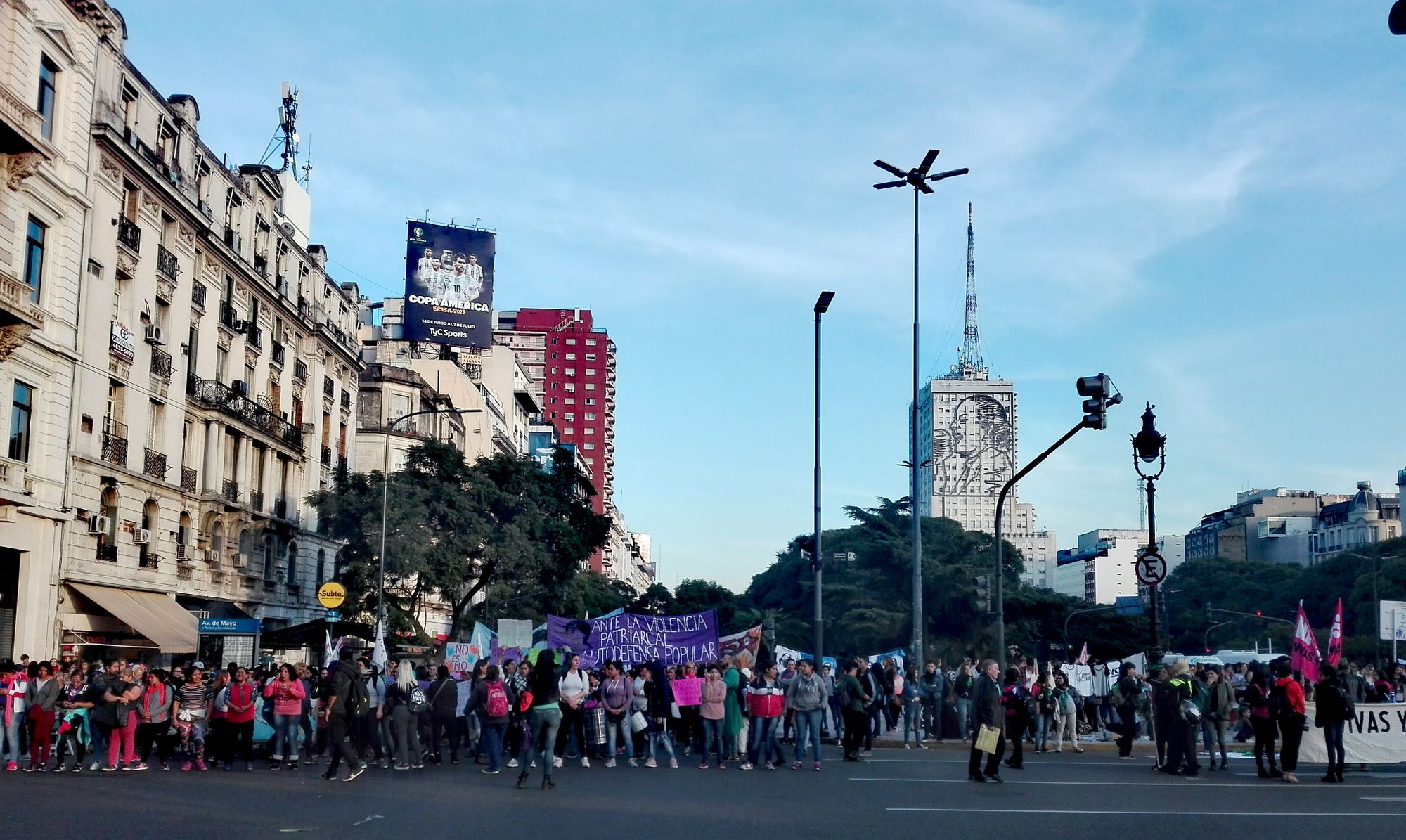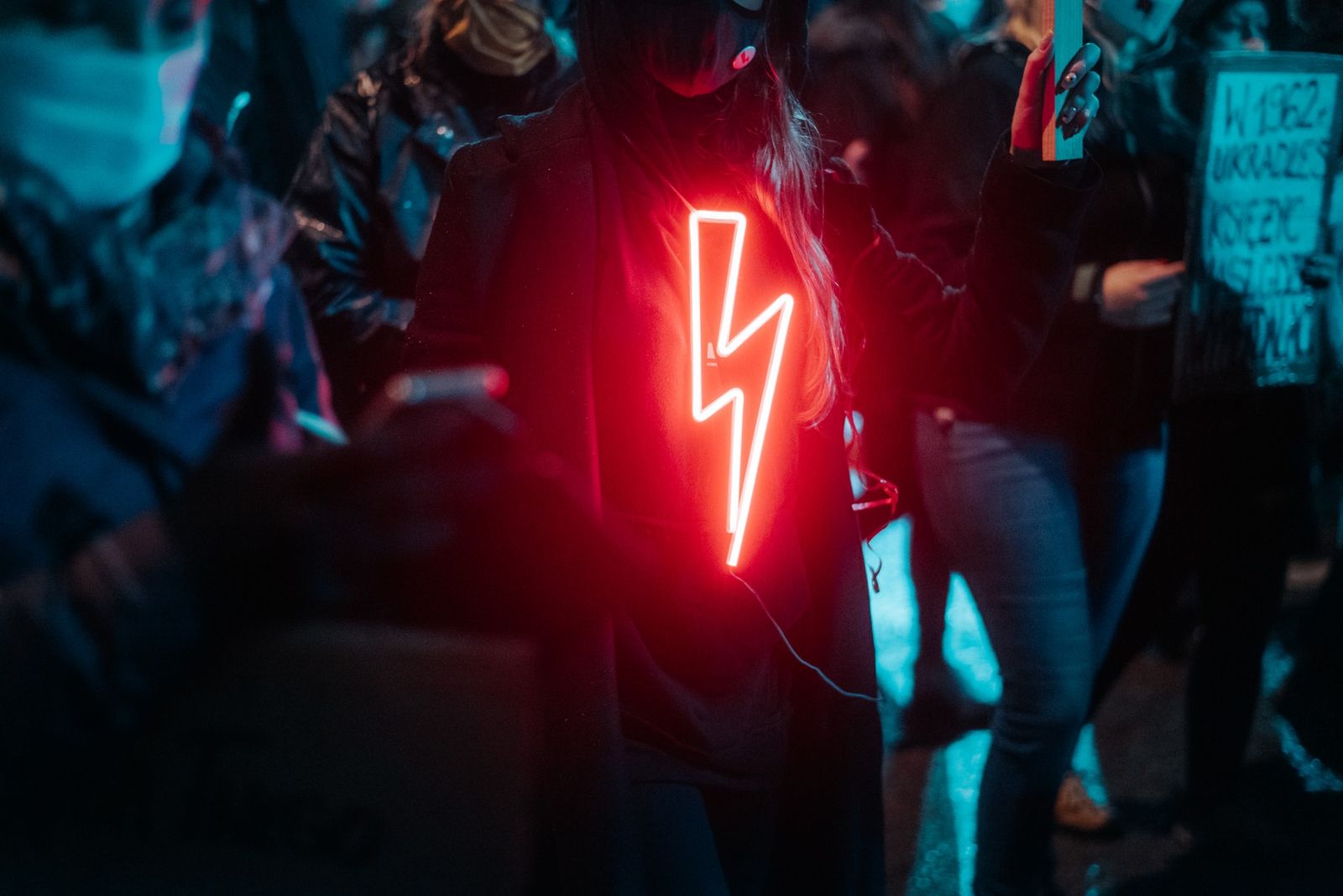Carrying signs reading “The revolution has a uterus” and “My Body, My Choice,” pro-choice protesters took to the streets in Poland in January 2021 to rally against the far-right government’s newly enforced restrictions on abortions. These restrictions ban the procedure except in cases of rape, incest, or when the woman’s life is in danger. Beyond painting their posters and faces with the Women’s Strike iconic red lighting bolt, many Polish protesters wore green scarves, a symbol drawn from Argentinian pro-choice activists. These green scarves arrived at Poland’s pro-choice protests thanks to social media, which has paved the way for nationally-focused activist movements to share symbols, tactics, and support across physical divides.
The green scarf was first used by Argentinian activists in 2015, in the early days of Argentina’s women’s movement. As the Guardian explains, “That green scarf was an allusion to the Mothers of Plaza de Mayo activists who wore white headscarves as they confronted Argentina’s vicious 1976-83 dictatorship over the disappearance of their children.” Argentina’s pro-choice movement gained early influence on social media; in 2015, Argentinian journalist Marcela Ojeda tweeted using the hashtag “#NiUnaMenos” (“Not One Less”) to refer to Argentina’s disturbing pattern of violence against women, now commonly known as “femicide,” the intentional, gender-based killing of women and girls. Ojeda’s tweet sparked the beginning of a nationwide movement of women using the hashtag to speak up against violence and systemic abuse.
Almost overnight, this hashtag became a critical public forum for Argentinian women to share their experiences with gender-based discrimination, from sexism in the workplace to intimate partner violence, challenging the traditional stigma surrounding discussions of femicide, abortion, and gender-based violence. Moving beyond social media discourse, Ni Una Menos became a coordinated movement after a series of localized protests paved the way for a large rally in Buenos Aires on June 3, 2015. After this rally, Ni Una Menos organizers partnered with pro-choice activists, taking on abortion access as a critical women’s rights issue and adopting the pro-choice movement’s green scarf as a broader symbol of activism for women’s health, safety, and wellbeing. Over time, this new pro-choice movement would come to be known as the “green wave” because of the protestors’ distinctive scarves and their dedication to protesting for legislative change to Argentina’s restrictive abortion laws, which banned abortion in all but the most extreme cases of rape and risk to the life of the woman.
In order to raise awareness for their causes and coordinate protests in over 70 cities in Argentina, both the pro-choice movement and Ni Una Menos relied heavily on social media. As Orlando James Jenkinson, a journalist formerly based in Buenos Aires, explains for the New Internationalist, “Activists, supporters and those affected by gender violence living outside of Buenos Aires all needed channels of communication the weekly meetings offered without necessarily having direct access to them. Social media provided a platform for speaking out generally free and for the most part easy to access. Sharing experiences of gender violence and abuse now trends in Argentina and beyond, alongside ‘#NiUnaMenos’ and under the hashtag ‘#Cuéntarlo’ (‘Tell it’).”
Ni Una Menos’s social media presence did not stop at Argentina’s borders. Inspired by the powerful images and testimonies shared with #NiUnaMenos on social media, other Latin American countries, including Chile, Peru, and Mexico, began using the hashtag, replicating Ni Una Menos’s large, public rallies, and displaying Ni Una Menos’s classic colors as symbols of solidarity with other Latin American women’s movements.
These global links have been forming since activism first took to social media. At the same time that Ni Una Menos was inspiring women's movements across Latin America, it was also drawing inspiration from Poland, forming a growing international pro-choice community based on mutual support. Cecília Palmeiro, Ni Una Menos organizer, explains that she was inspired by Polish women’s 2016 strike for abortion access to organize Argentina’s first National Women’s strike. This strike played a critical role in explicitly connecting gender-based violence to broader structures of power in Argentina.

Although Polish and Argentinian activists have been central to the international battle for abortion rights, technology has allowed the pro-choice movement to take root in countries across the world. In Ireland, activists clandestinely placed stickers in women’s bathrooms with a web address where women could get access to abortion pills outlawed by the conservative government. The information provided on these low-tech stickers connected curious women to an international network of pro-choice activists who help Irish women securely access abortifacients that are illegal in Ireland. While the grassroots activists papering Dublin bathrooms with stickers made up a critical facet of Ireland’s pro-choice movement, their work was facilitated and supported by the existence of online resources accessible across country borders, which was made possible with the international use of data and technology.
As Irish scholar Sydney Calkin explains, “Around the world, the pro-choice movement is building trans-national links, developing innovative technological and political workarounds, and expanding abortion access in creative ways.” For example, Dutch organization “Women on Waves” takes advantage of a maritime law provision that stipulates that a boat falls back under the legal jurisdiction of its own country after sailing past a 12-mile radius of a country’s shores. This means that the “Women on Waves” boat is allowed to provide abortions under Dutch law. Partnering with local pro-choice groups in countries where abortion is outlawed or heavily restricted, “Women on Waves” has successfully provided abortions to women around the world, including in Ireland, Poland, Morocco, and Guatemala. While the actual provision of healthcare services requires physical presence, “Women on Waves” campaigns rely heavily on the kind of international collaboration that has helped form and inspire pro-choice movements globally.
While the coalition of women's movements in Latin America may have begun as a series of tweets and hashtags, it has now transitioned into a global resistance movement that provides strategies and services across borders. Back in Argentina, though, activists are currently celebrating a hard-earned success; after five years of near-constant activism in the face of countless obstacles, including pushback from the Catholic Church, pro-life groups, and the COVID-19 pandemic, the Ni Una Menos movement finally succeeded at pressuring the Argentinian legislature to lift abortion restrictions before the first 14 weeks of pregnancy, making Argentina the third country in Latin America to legalize elective abortion. Beyond improving health outcomes for Argentinian women, this legislative success has inspired pro-choice protesters in other countries, particularly Poland, as they continue to fight against restrictive abortion bans in their own nations.
Unfortunately, as Ni Una Menos leaders celebrate their well-deserved legislative victory, the international pro-choice movement is facing increasing challenges from the pro-life movement’s weaponization of technology and data. Just as pro-choice movements have taken to social media to increase abortion access and inspire an international protest coalition, pro-life movements have created online communities dedicated to spreading the pro-life message, inspiring young pro-life advocates, and discouraging abortions. From Facebook to TikTok, the pro-life movement has leveraged social media not only to build international connections with like-minded individuals, but also to intercept women seeking abortions and direct them to anti-abortion resources. Mirroring the structure of physical “crisis pregnancy centers,” pro-life groups have set up virtual pregnancy counseling resources to urge women to carry their pregnancies to term—even providing misinformation about abortion—and to gather data on individuals seeking abortions. This data is then used by various pro-life groups to craft more targeted restrictions on abortion in countries around the world.
These hidden data gathering schemes are significant in both scope and magnitude. Privacy International’s April 2020 report on data surrounding reproductive rights details ten different exploitative data tactics used regularly by the anti-abortion movement to curtail women’s access to safe and legal abortion. One such tactic involves gathering data on women who seek advice and support during their pregnancy. The largest pro-life institution gathering this data is Heartbeat International, which strategically tracks the personal information of women who use their crisis pregnancy centers at “over 2500 locations worldwide,” almost 1000 of which are outside of the US.
Pro-life data gathering does not just occur in the context of pregnancy counseling; other services that track women’s health information have been utilized as data-gathering sources for anti-abortion groups. One popular menstruation-tracking app, “Femm,” was exposed in 2019 as a data-gathering source for anti-abortion organizations. Funded almost entirely by pro-life activists, “Femm” steered women exclusively toward pro-life doctors and provided scientifically inaccurate information about abortion and hormonal birth control. Anti-abortion groups’ exploitative data practices that violate privacy and provide misleading information about reproductive health services ultimately curtail women’s ability to make informed health decisions, regardless of the legal restrictions on abortion.
The weaponization of data by anti-abortion groups has been met with resistance from pro-choice activists. As a spokesperson for the British Pregnancy Advisory Service explained in 2020, women’s movements in various countries are working “together on a global level to expose and advocate against this new threat to reproductive rights” by reaching out to vulnerable populations and providing fact-based resources and information about reproductive health. On both sides of the abortion fight, technology has transformed abortion rights from a national, legislative issue to an international, ideological battle being fought with data. If pro-choice groups want to continue to build on the momentum of the international women’s movement, they will have to do so with a clear focus on technology’s potential for both activism and exploitation.





